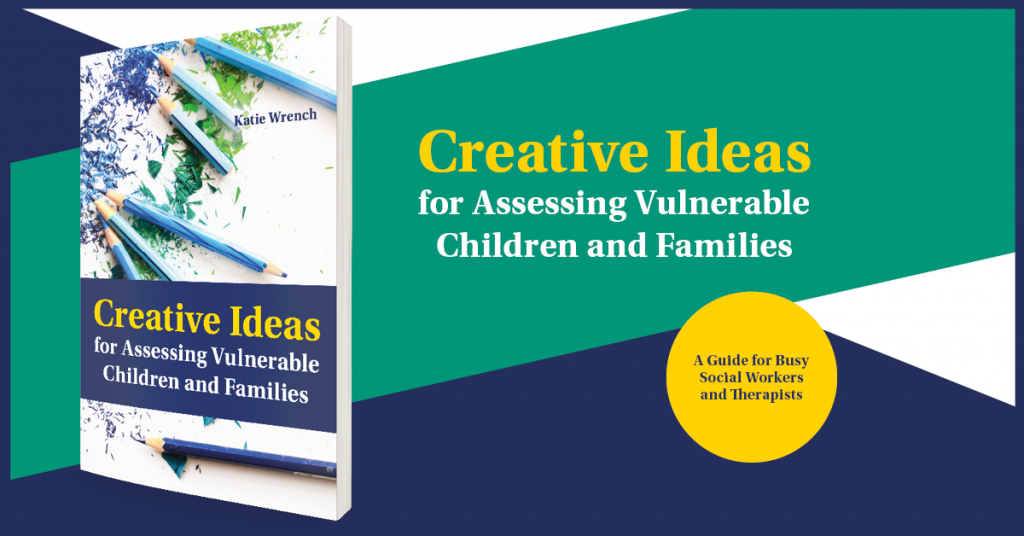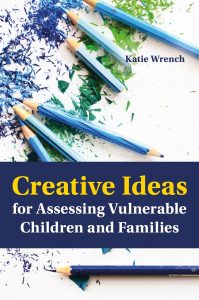 An article by author Katie Wrench
An article by author Katie Wrench
There are so many books about assessment – in social work and other fields. So why should you put your hand in your pocket and invest your hard-earned cash in yet another? What makes this one different? Here are my top 10 reasons why… in no particular order.
- We must offer a trauma informed response to children and their families. In social work we often become involved in families’ lives at times of incredible stress and distress. Our job is to support, to provide protection if necessary, to advocate for, to work with, not ‘do to.’ But consider how able you are if you are under chronic stress, are highly distressed or have recently experienced a traumatic event, to talk coherently about how you feel to a relative stranger, to explain clearly what happened, to think logically about what to do next? When we place too much value on verbal communication at times like these, we are often literally asking children and families to do something their brains are incapable of doing at that time. And then when there are inconsistencies in the ‘story’ or where the words being spoken don’t fit with the affect expressed, we can doubt the veracity of that story. As social workers we need to have a sound understanding of the impact of trauma on development, on the brain, and on communication if we are to work with families to produce a comprehensive and fair assessment of their needs. We need to utilise strategies to support children and families to feel safe enough to engage with us. By only prioritising verbal communication in assessments we potentially compromise the efficacy of that assessment and therefore compromise the outcomes for children and families.
- We need to build safety into assessments; relationships are key to this. As assessors we must be able to reflect on how we use ourselves; what do we do that enhances communication and builds trust? You’ll be prompted to consider how your actions, words or non-verbal communication might contribute to resistance or create barriers to communication? You’ll be encouraged to work restoratively with families to improve outcomes for children and their families.
- Creativity is a wonderful thing. By offering opportunities for art making or play within assessments we introduce a new language. Experiences that may be unspeakable can be given expression They can be both seen and heard. This applies equally to children, adolescents and adults, where we need to work hard when exploring trauma memories NOT to retraumatise the individual. It can help to work at a creative, sensory, embodied level, where children and their caregivers can engage all their senses in a safe, connected way to share their stories.
- When I was researching what social workers would want in a new book about assessment, the primary feedback was a perceived lack of confidence in undertaking assessments where people have additional communication needs in relation to language and culture or where children and caregivers have complex health needs or disabilities. So, you will find some top tips on ensuring you are engaged in culturally competent assessments, on working with interpreters and on communication with children and adults with additional needs, together with links to valuable free resources and guidance.
- Most practitioners are busy people. We can easily fall back on the same activities we’ve done with children and families a hundred times before or assume, when under pressure, that the quickest way to elicit the information we think we need to cover in an assessment session is by talking and asking questions. Working more creatively doesn’t mean we need more sessions; in fact, it can be a much more efficient way of engaging families as well as being more sensitive to the needs of vulnerable and traumatised children and families. There are ideas about what to have in your creative tool kit, but also what resources might help soothe over-aroused/stressed systems in children and young people.
- None of the activities or creative ideas I suggest requires costly resources. Most can be done with pens and paper. For others you can make prompts/resources that you can easily reuse if you invest in a laminator. If you want to ‘go wild’ or really support others to express their creativity, then you are free to develop the techniques and your resources. There are handy hints to give you ideas about how to develop or adapt the exercises.
- The activities are themed, so you can easily find what you’re looking for. For example, if you want to explore the family history or intergenerational patterns of relating, look at chapter 5, Hearing the Family Stories. If you want to understand more about the relationship between a parent and child, then look at the frameworks for observation in chapter 6 or chapter 4 Exploring and Understanding the Nature of Relationships, which will help you explore the complexities of recording and interpreting what you see. If you need to explore a specific worry or concern, then you’ll find ideas in chapter 8, What’s the problem? Exploring risks and needs. And all the research evidence highlights the fundamental need to understand what a day in the life of a child looks like, so in chapter 6, Exploring Every Day Lived Experience, you’ll find lots of ideas of how to do this creatively.
- If you’re a student or newly qualified worker who needs to build a direct work tool kit, or a more experienced worker who is motivated to extend their repertoire, you’ll find the most effective assessment activities and ideas from a range of diverse sources, all brought together in one place. Each exercise is simply formatted and will tell you what resources you’ll need, the aims of the activity, the process and then some handy hints with suggestions for extension, adaptation or pitfalls. It’s really hard to go ‘wrong,’ but it’s always great to practice first.
- I wanted this book to above all be a practical, useable resource. Although each chapter is evidence informed and has an introduction which summarises the theoretical basis and context for the work, there are no case studies, and the focus is on supporting safe, relational practice. You don’t have to read the book from cover to cover to be able to use it. The idea is that you can dip in and dip out – it is a response to social workers rarely having the time they would like to plan sessions before they leave the office. If you build up a portable creative tool kit that you can keep in your car boot or bag, then you should be able to scan the book quickly, find an appropriate idea that will support you in your assessment, and go and spend your time productively out in the community with families, where I think most of us would rather be.
- Different organisations are working to different assessment frameworks across the UK. The relationship -based principals and creative ideas in this book can overlay any formal framework and are a reminder that ultimately it will be the relationship rather than the model that helps you undertake a robust assessment, which will in turn help you collaboratively identify what a family needs and improve outcomes for vulnerable children and their families.
Katie Wrench has been a therapeutic social worker for 15+ years, as well as an art psychotherapist. She is currently the manager of the Therapeutic Social Work Team at Leeds Children’s Social Work Service.
Creative Ideas for Assessing Vulnerable Children and Families provides support to busy social workers in assessing the needs of vulnerable children and their families or caregivers, the book is based upon tried-and-tested methods from an experienced social worker and offers handy practical hints throughout. Ideal as a quick reference guide for everyday practice.
If you would like to read more articles like this and get the latest news and offers on our social work books, why not join our mailing list? We can send information by email or post as you prefer. You may also be interested in liking our Social Work, Mental Health and Health Care Facebook page.

I work in a school for 11 to 18 year olds with some vulnerable students so looking for as much help as possible in child protection, this seems ideal